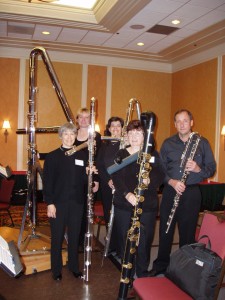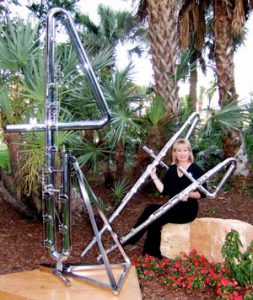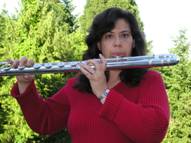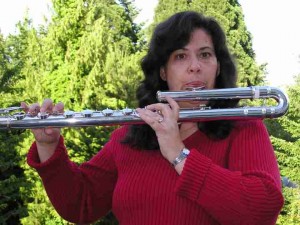Getting Started Playing Alto, Bass and Contrabass Flutes by Phyllis Avidan Louke

As flute choirs get more and more popular, more flutists are purchasing alto, bass and contrabass flutes than ever before, both to play in flute choirs, as well as to explore the expanding repertoire written for the larger flutes. Although the basic fingerings and written range are the same in all members of the flute family, the larger diameter of the tubing in alto, bass and contrabass flutes require the player to make adjustments in air management, hand position and alignment of the instrument that differ from those used when playing concert flute.
Larger flutes require more air. The alto, bass and contrabass being successively larger than the concert flute, both in diameter and in length, require successively larger volumes of air to play along with proper support of the air column to achieve a pleasing and projecting tone. For comparison purposes, approximate measurements of concert flutes are
| Instrument | Diameter | Length |
| Concert Flute | ¾” | 26½” |
| Alto Flute | 1” | 34” |
| Bass Flute | 1¾” | 52” |
| Contrabass Flute | 2” | 104” |
All measurements are for instruments with a c-foot.

Thank you to Paige Long for the following measurements of even larger flutes….
| Instrument | Diameter | Length |
|---|---|---|
| Contrabass in C (wide bore) | 2.2 inch | 9.3 feet of tubing |
| Sub Contrabass in G | 2 inch | 11.2 feet tubing |
| Double Contrabass in C | 3.5 inch | 18.1 feet of tubing |
All measurements are for instruments with a b-foot.
Alto flutes are pitched in the key of G, a perfect fourth below the concert flute. Since the embouchure hole and tube diameter are larger than those of the concert flute, and the instrument is almost 8 inches longer, a slightly wider aperture in the embouchure is necessary to provide a sufficient volume of air to play the alto flute. Bass flutes sound one octave lower than the concert flute and are almost twice as long with an even larger embouchure hole and more than double the diameter, requiring even more air and a wider aperture than for the alto flute. Contrabass flutes sound two octaves lower than the concert flute and are approximately twice as long with a larger diameter than the bass flute, requiring even more air and a slightly wider aperture. Sometimes it’s helpful to think about blowing into a pop bottle to play a note, to get the air stream wide enough for the larger flutes.
Air management: finding the best air speed and angle. While the upper octaves are the strongest and loudest for the concert flute, they are the weakest octaves for the larger flutes. Although the higher notes have a beautiful and ethereal quality in alto, bass and contrabass flutes, finding the proper air speed and angle for the air stream to play these notes accurately requires finesse, as they can be overblown easily—the larger the flute, the easier it is to over blow the higher notes.
When playing alto, bass or contrabass flute, the airspeed used should be slightly slower than for concert flute, especially for notes in the second and third octaves. When playing concert flute, many flutists increase the airspeed in the higher octaves. If the airspeed is too fast when playing a high note on one of the larger flutes, it may result in a harmonic instead of the desired note.
When playing an alto, bass or contrabass flute for the first time, it is advisable to warm up and get to know the instrument. Start slowly with some long tones on notes on notes such as A, G and F in the first octave, to determine the air stream width and speed necessary to produce a good tone. Remember that playing the larger flutes requires more air than playing the concert flute. Then play octaves to determine proper air speed and angle of the air stream–F1 and F2, G1 and G2, and A1 and A2 are good notes to start with. When these notes can be played comfortably, proceed to playing octaves through the chromatic scale starting from C1 to at least G3, getting to know the proper air stream angle of the notes through most of the range of the instrument. In subsequent practice sessions, it is advisable to play through this octave exercise with an electronic tuner to determine intonation idiosyncrasies of the particular instrument, so it can be played better in tune. Playing one or two octave scales checking pitch with an electronic tuner is also a good way to determine the pitch tendencies of the instrument. The upper octaves of many big flutes can be notoriously out of tune and require the player to listen carefully and adjust individual notes to correct the pitch. The intonation upper octave notes can be sometimes be improved by using alternate fingerings.
Alignment of Big Flutes. Aligning the head joint in alto flutes with curved heads, bass flutes and contrabass flutes is more complicated than the one-piece head joint of a concert flute or straight head alto flute because head joints are made in two pieces for bass and alto flutes, and in three pieces for contrabass. Some experimentation may be necessary to find the optimum set-up position for the head joint.
[one_half]

[/one_half]
[one_half_last]

[/one_half_last]
Some alto and bass flute players set up the head joint to place the straight section of the head with the embouchure hole almost directly above the main tube of the instrument, while others prefer to place the curve toward the player’s body with the head joint on the same plane as the main tube of the flute. With the head joint set up above the center section of the flute most of the weight of the instrument is supported by the hands, while in the other set-up, the weight is divided between the hands and the chin. Once the curve of the head is adjusted, the embouchure hole should be set up parallel to the keys of the flute, or turned in slightly toward the player. When the curved section is readjusted, the position of the embouchure hole will also require readjustment. When setting up the head joint of the contrabass flute with its three sections that are shaped like the number 4, the straight head joint section should be perpendicular to the plane formed by the keys on the center section of the flute. After the curves are adjusted properly, the embouchure hole should be set up so that it is parallel to the floor or angled slightly toward the player. Once the player finds a good set up position, the head joint sections can be marked with a spot or line of ink from a permanent marker, or a spot of nail polish on adjoining sections to aid in more quickly finding the optimum position when putting the instrument together.
When putting together alto, bass and contrabass flutes, care should be taken to avoid any interference with the operation of the keys. For instance, when setting up a curved head alto or a bass flute head joint above the center section of the flute, make sure that there is enough clearance for the left hand first finger to operate the C key. If there is interference, angle the curved section of the head joint slightly back toward the player. Also, the spatula of the D# key of many bass flutes is shaped such that it extends past the joint connecting the foot joint with the center section of the instrument. Players with smaller hands might feel comfortable turning the foot joint slightly toward themselves to lessen the reach to the D# key, rather than lining up the rod of the foot joint with the center of the D key. Make sure that the operation of the D# key is not hindered by the post on the center section of the flute, and that it doesn’t interfere with the operation of the D key.
Contrabass flutes, like string basses, are played standing up and have an adjustable peg to customize the height of the instrument to the player. On the contrabass flute, the peg is attached to the foot joint. Care should be taken to set up the contrabass so that the player can comfortably play on the head joint while maintaining good posture. If the contrabass is set up a little too high, the player can take a step back from the instrument and tip the instrument slightly towards them, using the peg as a pivot point. Some players prefer this position as being more comfortable than playing with the body of the contrabass straight up and down parallel to the player’s body. Make sure to adjust the head joint segments so that the instrument is well balanced, otherwise it may tend to twist to one side, making it uncomfortable to play.
Balance of Big Flutes. While the balance points on an alto flute are quite similar to those on a concert flute, those on bass and contrabass flutes are quite different. When playing an alto flute with a straight head, the flute is balanced above the first joint of the left index finger, the chin, and the right thumb. This type of alto flute is almost 8 inches longer than a concert flute and requires a longer reach. Some players with smaller hands and shorter arms might find it difficult to reach the foot joint keys and would prefer to play an alto flute with a curved head. Alto flutes weigh more than concert flutes, and may cause a player to tire more quickly because of the extra energy required to support the weight of the instrument.
Alto flutes with a curved head joint positioned above the center section of the flute have the same balance points as the straight head alto, without requiring the extended reach of the arms to reach the right hand keys. When curved head alto flutes position the head joint parallel to the center section of the flute, the chin plays a more prominent role in the balance and support of the flute.
Most bass flutes are built with a crutch for the left hand that is designed to help support and balance the greater weight of the instrument. Most bass flute crutches consists of a T-shaped piece of metal with adjustable length that fits in the crook of the left hand on the soft tissue between the thumb and the first finger. The length of the crutch should be adjusted for the size of the player’s hand so that the left hand fingers can move freely and reach the keys with ease. Other crutch designs include one shaped like a bassoon crutch (Yamaha). At least one manufacturer’s instruments (Eva Kingma) are not generally built with a crutch, and another manufacturer (Kotato) uses a rod that attaches to the center of the bass flute supporting much of the weight of the instrument by resting between the player’s legs on the chair as the player sits.
While the crutch is responsible for much of the balance of the bass flute, the length of the instrument puts most of the weight of the flute on the thumb of the right hand. The increased weight of the bass flute can cause a player to tire more quickly than when playing a concert flute. In addition, the player may experience fatigue in the right hand when playing for long periods of time.
The contrabass flute is played standing up because of the size of the instrument—when assembled it stands over 6 feet tall. Even though the instrument is played in front of the body rather than off to the side like other members of the flute family, the flute is balanced similarly to other flutes with most of the support coming from above the first joint of the left index finger, the chin on the embouchure plate, and the right thumb.
Buying an Alto, Bass or Contrabass Flute. When buying an alto, bass or contrabass flute, the price can vary depending on many factors, including whether the instrument is silver plated or solid silver. While some alto flutes might be available in solid silver, basses and contrabasses generally are not because of the excess weight. Basses and contras from some manufacturers, as well as altos, are available with a solid silver head or a solid silver lip plate on the head joint. Within instruments from the same manufacturer, instruments made with any solid silver will be higher priced with those that are only silver-plated. Yamaha alto and bass flutes are made of a gold brass alloy with a lacquer finish rather than silver or silver-plate.
There is no standardized design of alto, bass and contrabass flutes among manufacturers. The instruments’ large size renders the keys on the center section of these flutes too large and too far apart for the hands of a normal size flutist to depress all of them directly. This necessitates the use of a series of buttons, some placed directly on the keys and others acting as levers connected to the keys, to enable a player to maintain a practical hand position when depressing the keys. Foot joint keys and the G# key are generally oversized and elongated so that the player can reach them. The location and size of keys vary, so it is important for players, especially those with smaller hands, to play test different models to find one that is comfortable to play and where the foot joint keys can be reached comfortably. Newer models have been designed with greater attention to ergonomics, so when shopping for used instruments, it is important to play test them for comfort as well as for performance.
Most alto flutes can be purchased with a straight head joint, a curved head joint or both. If purchased with both heads, a larger case that will accommodate both heads will be provided with the flute. Some alto flutes are available with a b-foot, and some higher end manufacturers have other options such as open holes or customized fit. Alto flutes fall into three distinct price ranges: $1300-$3000 (Jupiter, Pearl, Emerson, Trevor James, Jupiter DiMedici, and Gemeinhardt); $4800-$5100 (Altus, Sankyo, Yamaha, and Miyazawa-plated); and $7850-$13,000 (Eva Kingma, Muramatsu, Miyazawa-solid silver, and Haynes).
When purchasing a bass flute, it is important to ask whether the instrument comes with trill keys, as some of the less expensive models do not include them as a standard feature. Some bass flutes are available with a b-foot, and some higher end manufacturers have other options such as open holes or customized fit. Some bass flute models may be found with winged head joints, although they are more likely to be on older model instruments. Bass flutes fall into three distinct price ranges: $2300-$4500 (Jupiter, Emerson, Jupiter DiMedici, and Gemeinhardt); $6800-$8000 (Altus, Yamaha, and Eva Kingma); and $10,000+ (Kotato and Sankyo).
Contrabass flutes are currently being manufactured by Eva Kingma in The Netherlands and by Kotato in Japan. Options can include trill keys, and a b-foot is standard from both of these manufacturers. Prices range from $18,100-$21,000+. For the budget minded, Jelle Hogenjuis in Holland is manufacturing contrabass flutes from PVC pipe with brass keys that are priced under $3,000. These instruments look quite different from those manufactured by Kingma and Kotato. Many flute choirs have been happily using these instruments because of their affordability. For pictures and more information on specifications, see the website at http://home.hetnet.nl/~jelinbama/index.html
Repertoire for Alto, Bass and Contrabass. There are more and more solo pieces for alto and bass flute (and even contrabass flute) being written and published every day, mostly by specialty publishers such as ALRY Publications at www.alrypublications.com and Falls House Press at www.fallshousepress.com.
For more information on repertoire available for big flutes, a good resource is the 2004 Repertoire Catalogue for Piccolo, Alto Flute, Bass Flute by Peter van Munster, available at www.petervanmunster.nl.
In addition, a repertoire list is available on Chris Potter’s website, compiled by Christine Potter and Carla Rees at http://altoflute.net/html/repertoire.html
For More Information
An Artist’s Guide to Alto and Bass Flute Irene Maddox ALRY Publications
Alto and Bass Flute Resource Book Chris Potter Falls House Press
© Copyright 2004 Phyllis Avidan Louke. All Rights Reserved.